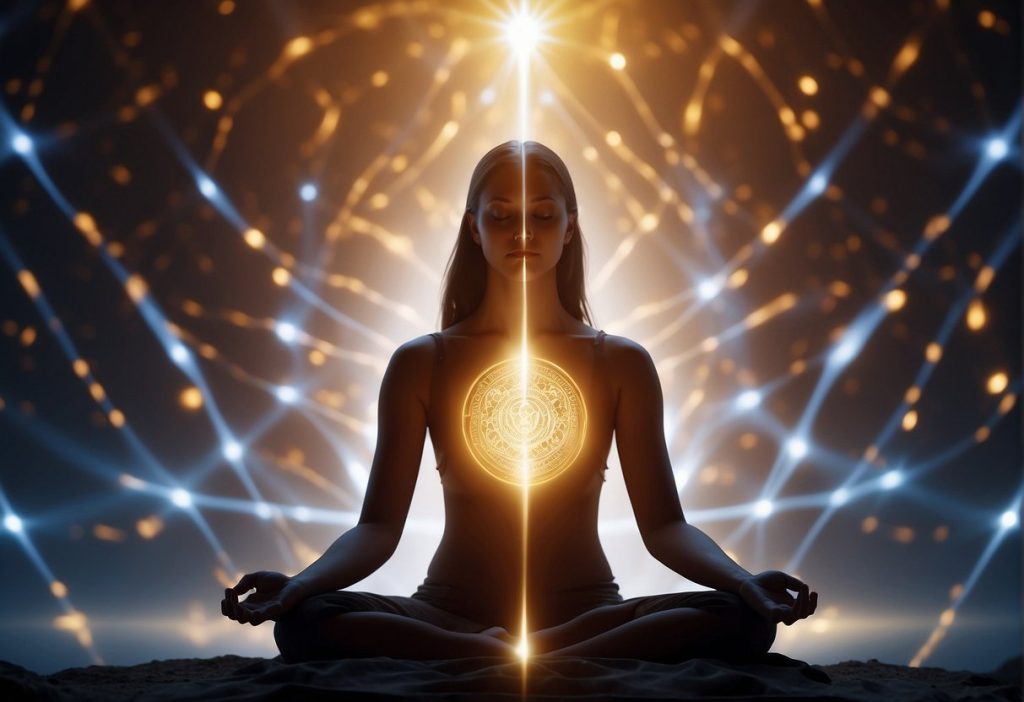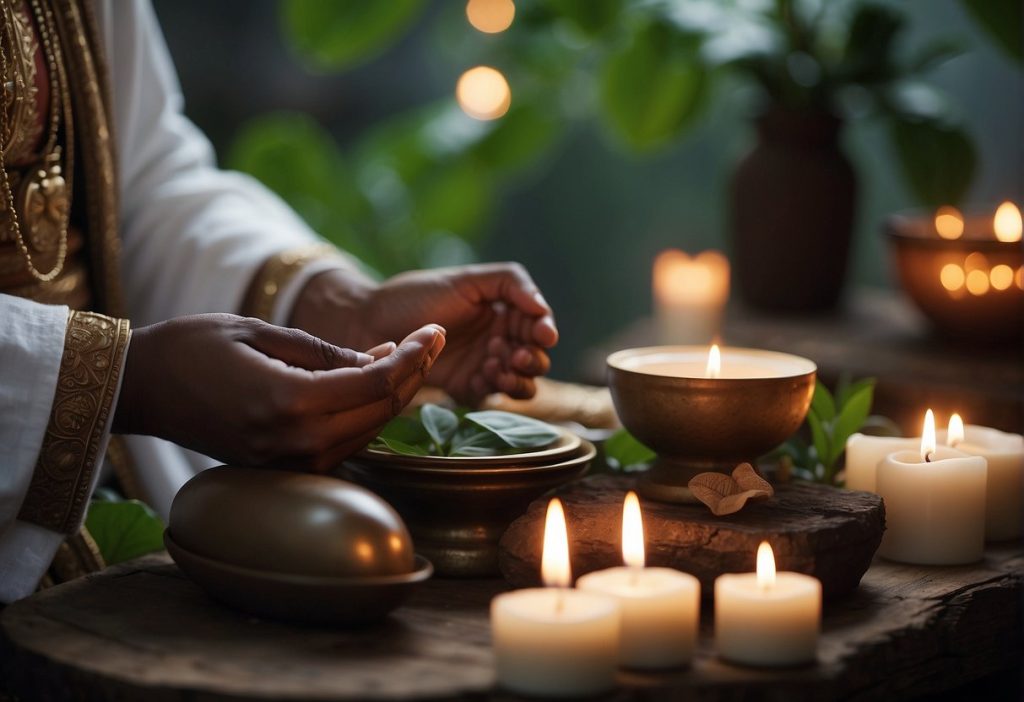Have you ever considered that a nagging pain in your shoulder or an unexplained ache in your knee might carry more than just a physical inconvenience?
Often, we look at pain as a purely biological response to injury or illness, but what if there’s more to the story?
Your body might be speaking to you not just through nerves and tissues but through a language that transcends the physical.
Picture this: every part of your body connected to a deeper, spiritual significance. The concept isn’t new; many traditions and philosophies have long seen the human body as a map to our inner experiences and emotions.
Could the persisting pain in your back be a signal from your subconscious indicating something unresolved? Or is that recurrent stiffness in your neck hinting at a burden you metaphorically carry?
Understanding Pain and Spirituality

The Link Between Body and Mind
Think about the last time you had a headache from stress. Wasn’t it interesting that your mental state had such a clear impact on your physical well-being?
This connection between body and mind isn’t just food for thought; it’s a well-recognized concept in many health disciplines.
Pain, in particular, can transcend its physical origins to reflect deeper emotional support needs or spiritual imbalances.
- Physical symptoms can sometimes be manifestations of emotional distress.
- Addressing both your mental and physical health is crucial for holistic well-being.
Pain as a Spiritual Messenger
But what if your persistent shoulder ache is trying to whisper some truths about your life?
Some believe that pain serves as a spiritual messenger, alerting you to areas in your life that may require your attention. These messages could be pointing towards personal growth or the need to reassess parts of your life that are out of balance.
- Identifying the emotional significance of your pain can lead to deeper self-awareness.
- Spiritual practices often incorporate techniques to understand and alleviate pain.
Cultural Views on Pain and Suffering
Every culture has its own take on why we experience pain and what it means. Some view it as a test of faith, while others see it as an inevitable part of life’s journey that carries lessons and opportunities for growth.
These beliefs can provide emotional support during challenging times and lend a deeper meaning to the experience of pain.
- Culturally influenced coping mechanisms can greatly affect one’s response to pain.
- Understanding a variety of cultural perspectives may broaden your own approach to pain management.
Interpreting Pain in Different Body Parts

Ever felt a peculiar pain and wondered if there’s more to it than just a physical annoyance? Let’s explore what your body could be whispering to you through pain.
Head and Neck
Experiencing a headache could mean more than just stress or dehydration. Headaches can sometimes reflect a need for a mental break or signal intellectual overload.
On the other hand, neck pain might suggest an unwillingness to consider other perspectives. It’s like your neck is literally stiffening against seeing the other side of the coin.
Shoulders and Upper Back
Carrying the world on your shoulders, are you? Pain in the shoulders may manifest when you’re shouldering more responsibility than you can handle.
Upper back discomfort? It could hint at a lack of emotional support or holding back feelings.
Chest and Heart
The chest protects your heart, the center of love and compassion. Pain here can sometimes imply emotional burdens or sadness.
No, it’s not like a cartoon heartbreak, but it does warrant a look into your emotional cupboard to see what’s expired.
Arms and Hands
Ever felt tied up in knots with pain in your arms? It might be your body nudging you about your ability, or lack thereof, to embrace life’s experiences.
And those hands? They could be aching to express creativity or to literally ‘handle’ life better.
Back and Spine
The backbone of your, well, backbone, is support. When your back aches, it could be suggesting a lack of support.
Maybe it’s time to take a stand or ask for the support you need? The spine aligns with self-support and your body’s structural integrity.
Hips and Legs
Your hips don’t lie—they’re about moving forward in life. Pain here might indicate a fear of moving into the future or making big decisions.
Pain in the legs? They carry you forward, so this could be a sign of reluctance or resistance to moving on from something.
Feet and Toes
Finally, those feet. The foundation of your physical being, pain here could mean a lack of balance or grounding.
And your toes? They help with balance and forward movement, so listen to them if they’re complaining—it might be time to step carefully or reassess your direction.
Remember, getting curious about your pain can uncover some insights, but it doesn’t replace medical advice—always check in with a professional for persistent aches. Now, let’s keep stepping forward, one relieved toe at a time!
Emotional and Psychological Associations of Pain

Ever wondered why your body seems to ache during times of high stress or emotional turmoil? It’s not just in your head—your emotions can manifest as physical pain.
Stress and Anxiety
When you’re stressed, your body tenses up. This fight-or-flight response can cause muscle tension leading to pain, particularly in your back and shoulders. Anxiety, a close cousin of stress, often goes hand-in-hand with this tension:
- Chest pain: Stress-induced anxiety can cause chest tightness or sharp pain.
- Headaches: Common during high-anxiety periods, they can range from mild tension to full-blown migraines.
Emotion-Focused Interpretations
Ever notice how guilt can sit like a weight in your stomach? It’s because emotions like guilt or emotional imbalance often tie into specific body pain:
- Stomachaches: May correlate with feelings of guilt or worry.
- Neck pain: Sometimes linked to stubbornness or an unwillingness to see another’s perspective.
Psychosomatic Pain
Psychosomatic pain is when psychological factors contribute to physical pain with no clear medical cause. Symptoms may include various pains indicative of underlying emotional issues:
- Back pain: Can reflect a lack of emotional support or feeling unloved.
- Arm pain: Sometimes associated with carrying emotional burdens or stress.
Spiritual Practices for Pain Management

Seeking relief from physical discomfort, you might be curious about how spiritual practices can aid in managing pain.
Beyond conventional medicine, these holistic methods offer peace and healing by addressing the mind-body-spirit connection. Ready to find some tranquility?
Meditation and Mindfulness
Have you ever noticed how calming the simple act of deep breathing can be? Meditation and mindfulness are all about bringing your attention to the present, helping alleviate pain by:
- Reducing stress: Regular meditation can lower the body’s stress response.
- Enhancing pain tolerance: Mindfulness increases awareness, potentially reducing the emotional response to pain.
Breathing Techniques
Breathing is something you do without thinking, but what if you could use it to combat pain? Deep breathing exercises can do wonders for pain management:
- Diaphragmatic breathing: Encourages full oxygen exchange and can reduce the sensation of pain.
- Rhythmic breathing: Maintains focus and promotes relaxation, which may ease pain.
Yoga and Flexibility
Ever heard that a flexible body houses a flexible mind? Yoga intertwines physical postures with breath work to enhance flexibility, which might:
- Improve circulation: Enhanced blood flow can encourage healing in painful areas.
- Boost endorphins: These natural painkillers are released during gentle stretching and yoga practices.
Energy Healing and Chakra Balancing
Do you feel off-kilter when you’re in pain? Energy healing practices, such as Reiki, operate on the premise that pain is a result of blocked energy channels, and balancing them can:
- Restore harmony: A balanced energy flow is believed to promote the body’s natural healing abilities.
- Relieve pain: Aligning chakras may diminish the intensity of pain by fostering physical and spiritual well-being.
Remember, incorporating these practices into your pain management routine is a personal journey. It’s all about finding what resonates with you and your needs. So why not give it a try and see how your body and mind respond?
Overcoming Common Spiritual Blocks

Let’s explore how you can tackle spiritual hurdles that might be holding you back. Remember, it’s not just about recognizing these blocks but actively working through them. Ready to clear the path?
Addressing Fear and Resistance
Have you ever felt an invisible wall stopping you in your tracks? That’s often fear and resistance to change, two mighty contenders in your spiritual journey. Conquering them involves a mix of self-reflection and courage. Try this:
- Identify your fear by writing it down; bring it into the light.
- Speak with someone you trust about these fears. It’s okay to seek help!
Take baby steps rather than leap; every small victory over your fear is progress.
The Role of Forgiveness
Have you been holding onto old grudges or blame? Forgiveness is not just a lofty ideal; it’s a crucial step in removing spiritual blockages. Practicing forgiveness allows you to release past hurts and move forward. Start with:
- Forgiving yourself; it’s essential and often the hardest step.
- Practicing empathy to understand that everyone has their struggles.
By forgiving, you unlock a lighter and more fulfilling spiritual path.
Embracing Change and New Beginnings
Change can be daunting, but it’s the only constant, right? Embracing new beginnings often requires a leap of faith—a trust in the unknown. Here’s how you can embrace change:
- Reflect on times when change brought unexpected rewards.
- Set intentions for the changes you’d like to invite into your life.
Remember, embracing change is like opening the door to new possibilities—go ahead and turn that knob! Your adventure awaits on the other side.
Pain and the Journey of Self-Discovery

When you experience pain, it’s not just your body speaking; it might be an invitation to a profound internal journey. Let’s dive into how pain can lead to introspection, spiritual awakening, and invaluable life lessons.
Pain as a Path to Introspection
Have you ever thought about what your pain is trying to tell you? It’s like your body is nudging you to look closer at your life choices and emotional well-being. Pain often serves as a catalyst for you to pause and reflect on where you are and where you want to be. It’s not just about the physical sensation but what it signifies regarding your current state of mind and life situation.
Spiritual Awakening Through Pain
Sometimes, pain is the wake-up call you never knew you needed. It challenges you to seek deeper understanding and can lead to unexpected spiritual growth. For instance, chronic discomfort might nudge you to explore meditation or mindfulness, leading to a newfound sense of clarity about your life’s purpose. This awakening can bring about a transformative change in how you view yourself and the world around you.
Lessons Learned from Physical Discomfort
Believe it or not, pain can be one of your greatest teachers. Each ache may harbor a lesson in patience, resilience, or letting go. For example:
- Lower back pain? Maybe it’s telling you to strengthen your core or to address issues of support in your life.
- Headaches? Perhaps they’re linked to stress, encouraging you to find balance.
The key here is to listen and learn. Your body’s signals can guide you to make positive changes, both physically and emotionally, ultimately leading to enhanced self-discovery.
Incorporating Spiritual Support and Community

When it comes to healing, the support you garner from others and the community you’re part of can make a world of difference. Never underestimate the warmth of a shared experience or the strength that comes from a community that understands your journey. Let’s explore how to weave that essential emotional and collective support into your path to wellness!
Seeking Emotional Support
Have you ever noticed how a problem seems lighter when you share it? That’s the beauty of emotional support. It’s not just about venting; it’s about feeling understood and connected. Here are your go-to strategies:
- Identify Trustworthy People: Your family, friends, or support groups can be your pillars. They’re the ones you’d call at 2 AM without hesitating!
- Talk it Out: Sometimes, the simple act of talking can untie knots in your mind. Look for someone who listens without judgement and offers empathy.
The Power of Collective Healing
Ever been to group therapy or a meditation circle? Then you know there’s something almost magical about healing together. Collective healing plays with this magic. It’s like:
- Group Therapy: Bonding over shared pains strengthens your resolve.
- Meditation or Prayer Groups: Shared spiritual practices can amplify your intentions and lead to deeper healing.
Spiritual Traditions and Community
Your community often holds the key to a treasure chest of spiritual wisdom. It’s like having access to a spiritual library built over generations! Here’s how to tap into that:
- Participate in Community Rituals: Whether it’s a candlelight vigil or a communal prayer, joining in can root you in a sense of belonging.
- Learn from Spiritual Leaders: Their insights might just spark that aha moment you’ve been searching for!
Remember, a journey toward healing isn’t a solo trek – it’s a caravan of fellow travelers sharing their light with you. With each step, lean on your fellow journeyers, and don’t be shy to contribute your own sparkle to the collective glow!
Conclusion
Your body is your ally, and its messages, though sometimes cryptic, are worth decoding.
While no specific numbers or statistics can quantify the spiritual influence on pain, many find comfort in this perspective.
Pain doesn’t have to be the end of the story—it can be the beginning of a new chapter in understanding and nurturing your well-being.





